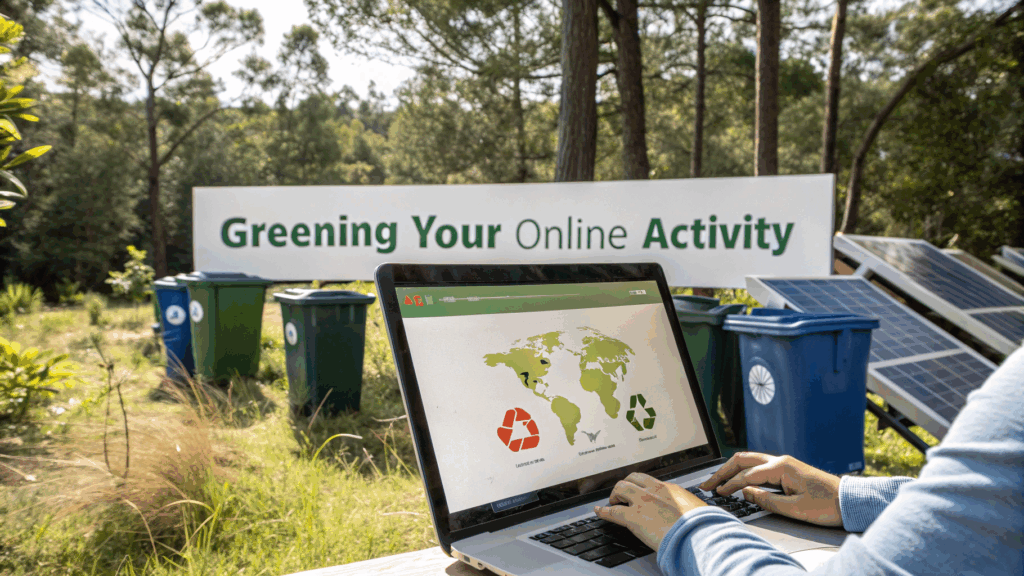Smart but Sustainable: Rethinking Tech Habits for Greener Days
In today’s hyper-connected world, we rely on technology for almost everything—from work and education to entertainment and communication. Smartphones wake us up, laptops power our productivity, and smart home devices manage our energy use. While tech enriches modern life in countless ways, it also contributes significantly to environmental degradation. In the race for speed, efficiency, and constant upgrades, sustainability often takes a back seat.
“Smart but Sustainable” is more than just a buzz phrase—it’s a call to action. It encourages individuals, communities, and companies to reflect on their digital habits and make conscious choices that balance innovation with ecological responsibility. This article explores how you can align your tech habits with the planet’s needs without sacrificing convenience or progress.

1. Understanding the Environmental Cost of Tech
Before we can change our tech habits, it’s essential to understand the hidden environmental toll of our digital lives.
a. Device Manufacturing and Resource Extraction
Modern gadgets are made from a complex mix of metals, plastics, and rare earth elements like lithium, cobalt, and neodymium. These are mined in ways that often lead to deforestation, pollution, and unethical labor practices. For instance, cobalt mining in the Democratic Republic of Congo has been linked to child labor and severe ecological damage.
Manufacturing these devices is also energy-intensive. Studies show that nearly 70-80% of a smartphone’s total carbon emissions occur during its production. This includes the extraction, refining, and assembly processes that take place across global supply chains.
b. E-Waste Crisis
According to the Global E-Waste Monitor, the world generated more than 59 million metric tons of electronic waste in 2022. That’s equivalent to throwing away 1,000 laptops every second. Most of this waste is not properly recycled, leading to toxic chemicals leaking into soil and water systems. Devices are often discarded not because they are unusable, but because newer models are more appealing or because the old ones are no longer supported by software updates.
c. The Digital Carbon Footprint
Many people don’t realize that our online activity has a carbon cost. Every email, video stream, and cloud storage access requires energy. Data centers—the physical infrastructure behind the internet—consume about 1% of the world’s electricity. Video streaming alone contributes an estimated 300 million tons of CO₂ annually, equivalent to the annual emissions of Spain.
2. Shifting to More Sustainable Tech Habits
Living smart but sustainably doesn’t mean giving up technology. It means using it thoughtfully. Here are key areas where you can make a difference:
a. Prolong the Life of Your Devices
Why it matters: The most sustainable device is the one you already own.
What you can do:
- Avoid upgrading for minor improvements. Keep devices longer, ideally 4–5 years for smartphones and 6–8 years for laptops.
- Use durable cases and screen protectors to prevent damage.
- Regularly maintain and update software to keep devices running efficiently.
- Learn basic repairs or use services that extend your gadget’s lifespan, such as battery or screen replacement.
b. Buy Responsibly
Why it matters: Every purchase sends a signal to manufacturers.
What you can do:
- Choose tech brands that prioritize sustainability, such as those using recycled materials or supporting the right-to-repair.
- Opt for energy-efficient models with Energy Star or EPEAT certifications.
- Prefer modular gadgets (like Fairphone or Framework) that allow parts to be replaced instead of the whole device.
c. Rethink Consumption Habits
Why it matters: Digital minimalism reduces clutter and energy waste.
What you can do:
- Uninstall unused apps and delete redundant files or photos.
- Use cloud storage efficiently; avoid hoarding unnecessary data.
- Stream in standard definition when HD is not necessary—especially on mobile devices.
- Mute auto-play features on apps and browsers to limit data usage.
3. Greening Your Online Activity
Even if your gadgets are sustainable, the way you use the internet also matters.
a. Reduce Your Streaming Impact
Video streaming is one of the most energy-demanding online activities. The higher the quality, the more data (and energy) it consumes.
Tips:
- Download music or videos for offline use instead of repeatedly streaming.
- Lower video resolution on smaller screens—480p often suffices on smartphones.
- Limit background streaming during multitasking or sleeping hours.
b. Manage Cloud and Email Storage
Each file saved to the cloud consumes electricity from servers running 24/7.
Tips:
- Delete old emails with large attachments.
- Organize and clear out cloud files regularly.
- Turn off automatic backups for non-essential apps and data.
c. Optimize Work-From-Home Practices
Remote work reduces commuting but increases home energy use and online activity.
Tips:
- Use energy-efficient lighting and devices.
- Turn off your laptop and monitor when not in use.
- Schedule virtual meetings mindfully and avoid unnecessary large file transfers.

4. Smart Homes, Smart Choices
Smart home devices promise energy efficiency, but they also contribute to resource consumption and data center demand.
a. Assess Smart Device Necessity
Ask yourself:
- Does this device genuinely save energy or just add convenience?
- Can a traditional alternative do the job more sustainably?
Tip: Use smart thermostats and lighting systems that demonstrably reduce energy use, but avoid unnecessary “smart” gadgets like Wi-Fi-connected toasters or voice-activated garbage bins.
b. Automate for Efficiency, Not Excess
Automation can reduce waste—if set up thoughtfully.
Tips:
- Program thermostats based on actual occupancy and climate needs.
- Use motion sensors for lighting in low-traffic areas like hallways or bathrooms.
- Avoid leaving devices on standby mode for long hours. Use smart plugs to cut power completely when devices are idle.
5. Responsible Disposal and Recycling
Eventually, all gadgets reach the end of their useful life. What you do next makes a huge difference.
a. Reuse or Donate
If the device still works:
- Give it to a friend or family member.
- Donate it to schools, nonprofits, or tech refurbishing programs.
b. Recycle E-Waste Properly
How:
- Use certified e-waste recyclers with R2 or e-Stewards certification.
- Check if your local electronics store or government offers take-back programs.
- Don’t throw electronics in the trash—they can leach hazardous materials like lead, mercury, and cadmium.
c. Sell or Trade In
Many manufacturers and third-party services offer trade-in value for your old devices, providing an incentive to extend product life or allow safe reuse.
6. Corporate and Government Responsibility
While individual actions matter, corporations and governments must lead large-scale change.
a. Support Ethical and Transparent Companies
Consumers can demand accountability by supporting companies that:
- Use recycled materials and renewable energy.
- Provide clear information on carbon emissions.
- Allow users to repair, reuse, and recycle their devices easily.
b. Advocate for Policy Changes
Policies that encourage sustainable tech practices include:
- Right-to-repair laws that prevent companies from locking devices.
- E-waste legislation requiring manufacturers to manage end-of-life products.
- Incentives for companies that adopt circular economy principles.

7. Education and Community Awareness
Rethinking tech habits isn’t just a personal journey—it’s a collective one.
a. Teach Digital Sustainability
Schools and colleges can integrate digital sustainability into tech and science curricula. Awareness from a young age encourages lifelong eco-conscious behavior.
b. Promote Local Repair Culture
Repair cafes and DIY repair communities empower people to fix instead of throw away. These grassroots movements are growing around the world, helping reduce e-waste and restore value to craftsmanship.
c. Organize and Participate in E-Waste Drives
Community-led recycling events are an effective way to dispose of gadgets responsibly and spread awareness.
8. Looking Ahead: Toward a Circular Tech Economy
The ultimate goal is to transition to a circular economy in tech—a system where devices are designed to be repaired, reused, and recycled from the outset.
Future-forward trends include:
- Modular Design: Easy-to-repair devices with interchangeable parts.
- Biodegradable Electronics: Devices made with organic or plant-based materials.
- Green Data Centers: Facilities powered entirely by renewable energy with advanced cooling systems.
Artificial Intelligence (AI) and blockchain can also be leveraged to optimize resource usage, track supply chains, and improve recycling processes.
Conclusion: Smarter Habits, Greener Future
Technology isn’t inherently unsustainable—it’s how we design, use, and dispose of it that makes the difference. By rethinking our tech habits, we can reduce waste, conserve energy, and minimize our digital carbon footprints.
You don’t have to be an engineer or environmentalist to make a difference. Every decision—from holding onto your phone for an extra year to unsubscribing from unnecessary emails—sends a message. That message? We can be smart, and sustainable.
As we move forward into a world increasingly shaped by digital experiences, let’s ensure our tech-enhanced future is one that’s also green, just, and sustainable. Because smart living should not come at the planet’s expense.

